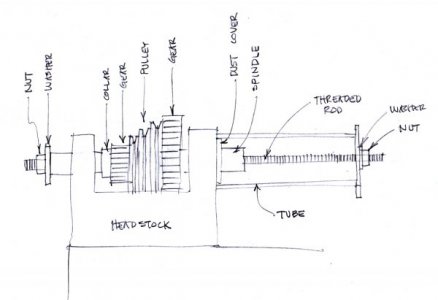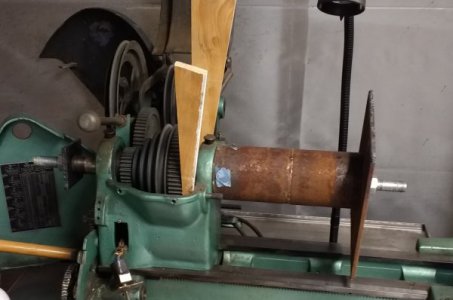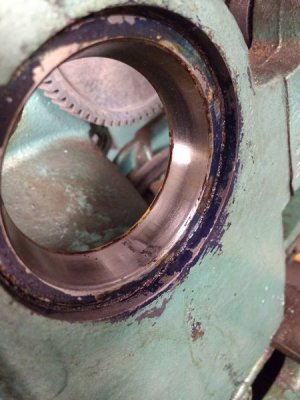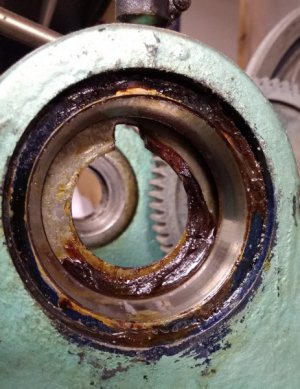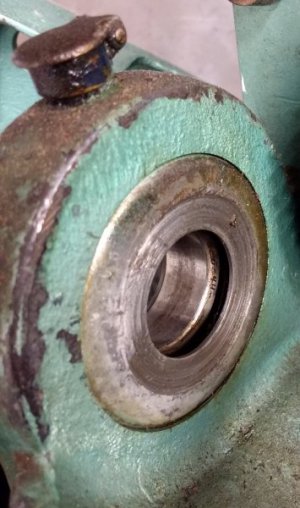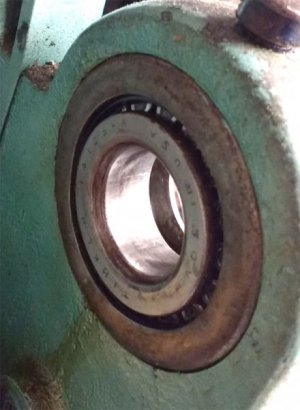- Joined
- Dec 25, 2011
- Messages
- 10,552
First, I would remove the countershaft and the back gears. They don't absolutely have to come off at this point but if you go ahead and remove them, they won't be in the way and they have to come off anyway to get the spindle belt on as you reassemble the headstock.
Second, confirm that the bull gear, spindle cone pulley, small spindle gear and collar are free to move a little ways toward the right. In other words, that they are all free on the spindle. Also, pull out the direct drive pin if you haven't already.
Third, I would do what I suggested to start with which is get a piece of mechanical tubing with an ID just larger than the right hand dust cover and of a length approximately as long as the distance from the right end of the spindle to the face of the bull gear, or the distance between the collar and the left end of the spindle, whichever is greater. Plus a shoulder washer about 1/2" or more thick to fit the right end of the mechanical tubing and one to fit the left end of the spindle. Plus a length of 3/4" dia. all-thread with two nuts and two standard flat washers.
Assemble all of this on the headstock, oil or grease the threads, rotate the spindle so that the key and key way in the bull gear are at about TDC, and tighten the nuts as tight as you can get them with standard wrenches. If this doesn't start the spindle moving, with paddle bits, drill a flat bottom hole in a piece of 4 by 4 just large enough to fit over the nut and shoulder washer and threads on the left end of the spindle and deep enough that the 4 by 4 chunk will sit there without having to hold it. Hit this with the largest hammer that you have. Once the spindle starts moving, remember not to pull the Woodruff key too far and into the inner dust cover before you start trying to grab it with pliers and remove it. Also, shortly after the spindle starts moving, it will get a little harder to move as the right spindle bearing cone starts forcing the right dust cover out ahead of it. And except while you are fighting to get the Woodruff key out, keep two wood wedges between the bull gear and the headstock casting to prevent chipping the teeth on the casting.
Maybe that will work.
Second, confirm that the bull gear, spindle cone pulley, small spindle gear and collar are free to move a little ways toward the right. In other words, that they are all free on the spindle. Also, pull out the direct drive pin if you haven't already.
Third, I would do what I suggested to start with which is get a piece of mechanical tubing with an ID just larger than the right hand dust cover and of a length approximately as long as the distance from the right end of the spindle to the face of the bull gear, or the distance between the collar and the left end of the spindle, whichever is greater. Plus a shoulder washer about 1/2" or more thick to fit the right end of the mechanical tubing and one to fit the left end of the spindle. Plus a length of 3/4" dia. all-thread with two nuts and two standard flat washers.
Assemble all of this on the headstock, oil or grease the threads, rotate the spindle so that the key and key way in the bull gear are at about TDC, and tighten the nuts as tight as you can get them with standard wrenches. If this doesn't start the spindle moving, with paddle bits, drill a flat bottom hole in a piece of 4 by 4 just large enough to fit over the nut and shoulder washer and threads on the left end of the spindle and deep enough that the 4 by 4 chunk will sit there without having to hold it. Hit this with the largest hammer that you have. Once the spindle starts moving, remember not to pull the Woodruff key too far and into the inner dust cover before you start trying to grab it with pliers and remove it. Also, shortly after the spindle starts moving, it will get a little harder to move as the right spindle bearing cone starts forcing the right dust cover out ahead of it. And except while you are fighting to get the Woodruff key out, keep two wood wedges between the bull gear and the headstock casting to prevent chipping the teeth on the casting.
Maybe that will work.

